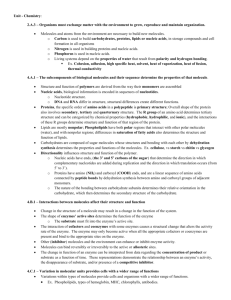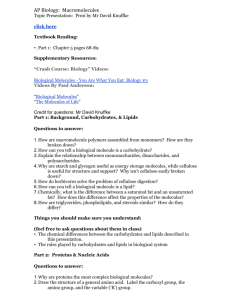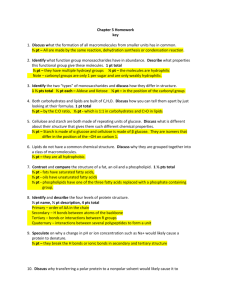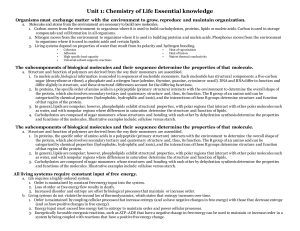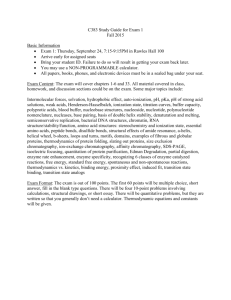AP_Bio_biochem_obj
advertisement
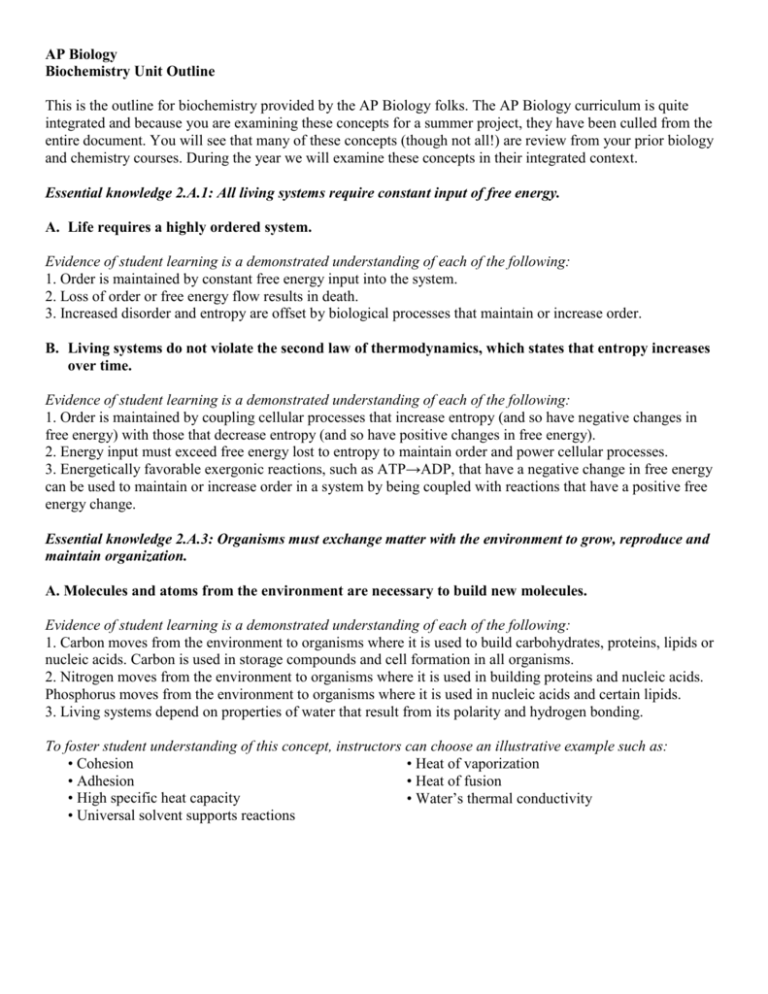
AP Biology Biochemistry Unit Outline This is the outline for biochemistry provided by the AP Biology folks. The AP Biology curriculum is quite integrated and because you are examining these concepts for a summer project, they have been culled from the entire document. You will see that many of these concepts (though not all!) are review from your prior biology and chemistry courses. During the year we will examine these concepts in their integrated context. Essential knowledge 2.A.1: All living systems require constant input of free energy. A. Life requires a highly ordered system. Evidence of student learning is a demonstrated understanding of each of the following: 1. Order is maintained by constant free energy input into the system. 2. Loss of order or free energy flow results in death. 3. Increased disorder and entropy are offset by biological processes that maintain or increase order. B. Living systems do not violate the second law of thermodynamics, which states that entropy increases over time. Evidence of student learning is a demonstrated understanding of each of the following: 1. Order is maintained by coupling cellular processes that increase entropy (and so have negative changes in free energy) with those that decrease entropy (and so have positive changes in free energy). 2. Energy input must exceed free energy lost to entropy to maintain order and power cellular processes. 3. Energetically favorable exergonic reactions, such as ATP→ADP, that have a negative change in free energy can be used to maintain or increase order in a system by being coupled with reactions that have a positive free energy change. Essential knowledge 2.A.3: Organisms must exchange matter with the environment to grow, reproduce and maintain organization. A. Molecules and atoms from the environment are necessary to build new molecules. Evidence of student learning is a demonstrated understanding of each of the following: 1. Carbon moves from the environment to organisms where it is used to build carbohydrates, proteins, lipids or nucleic acids. Carbon is used in storage compounds and cell formation in all organisms. 2. Nitrogen moves from the environment to organisms where it is used in building proteins and nucleic acids. Phosphorus moves from the environment to organisms where it is used in nucleic acids and certain lipids. 3. Living systems depend on properties of water that result from its polarity and hydrogen bonding. To foster student understanding of this concept, instructors can choose an illustrative example such as: • Cohesion • Heat of vaporization • Adhesion • Heat of fusion • High specific heat capacity • Water’s thermal conductivity • Universal solvent supports reactions Essential knowledge 4.A.1: The subcomponents of biological molecules and their sequence determine the properties of that molecule. A. Structure and function of polymers are derived from the way their monomers are assembled. Evidence of student learning is a demonstrated understanding of each of the following: 1. In nucleic acids, biological information is encoded in sequences of nucleotide monomers. Each nucleotide has structural components: a five-carbon sugar (deoxyribose or ribose), a phosphate and a nitrogen base (adenine, thymine, guanine, cytosine or uracil). DNA and RNA differ in function and differ slightly in structure, and these structural differences account for the differing functions. ✘✘ The molecular structure of specific nucleotides is beyond the scope of the course and the AP Exam. 2. In proteins, the specific order of amino acids in a polypeptide (primary structure) interacts with the environment to determine the overall shape of the protein, which also involves secondary tertiary and quaternary structure and, thus, its function. The R group of an amino acid can be categorized by chemical properties (hydrophobic, hydrophilic and ionic), and the interactions of these R groups determine structure and function of that region of the protein. ✘✘ The molecular structure of specific amino acids is beyond the scope of the course and the AP Exam. 3. In general, lipids are nonpolar; however, phospholipids exhibit structural properties, with polar regions that interact with other polar molecules such as water, and with nonpolar regions where differences in saturation determine the structure and function of lipids. ✘✘ The molecular structure of specific lipids is beyond the scope of the course and the AP Exam. 4. Carbohydrates are composed of sugar monomers whose structures and bonding with each other by dehydration synthesis determine the properties and functions of the molecules. Illustrative examples include: cellulose versus starch. ✘✘ The molecular structure of specific carbohydrate polymers is beyond the scope of the course and the AP Exam. B. Directionality influences structure and function of the polymer. Evidence of student learning is a demonstrated understanding of each of the following: 1. Nucleic acids have ends, defined by the 3' and 5' carbons of the sugar in the nucleotide, that determine the direction in which complementary nucleotides are added during DNA synthesis and the direction in which transcription occurs (from 5' to 3'). 2. Proteins have an amino (NH2) end and a carboxyl (COOH) end, and consist of a linear sequence of amino acids connected by the formation of peptide bonds by dehydration synthesis between the amino and carboxyl groups of adjacent monomers. 3. The nature of the bonding between carbohydrate subunits determines their relative orientation in the carbohydrate, which then determines the secondary structure of the carbohydrate. Essential knowledge 4.B.1: Interactions between molecules affect their structure and function. A. Change in the structure of a molecular system may result in a change of the function of the system. B. The shape of enzymes, active sites and interaction with specific molecules are essential for basic functioning of the enzyme. Evidence of student learning is a demonstrated understanding of each of the following: 1. For an enzyme-mediated chemical reaction to occur, the substrate must be complementary to the surface properties (shape and charge) of the active site. In other words, the substrate must fit into the enzyme’s active site. 2. Cofactors and coenzymes affect enzyme function; this interaction relates to a structural change that alters the activity rate of the enzyme. The enzyme may only become active when all the appropriate cofactors or coenzymes are present and bind to the appropriate sites on the enzyme. ✘✘ No specific cofactors or coenzymes are within the scope of the course and the AP Exam. C. Other molecules and the environment in which the enzyme acts can enhance or inhibit enzyme activity. Molecules can bind reversibly or irreversibly to the active or allosteric sites, changing the activity of the enzyme. D. The change in function of an enzyme can be interpreted from data regarding the concentrations of product or substrate as a function of time. These representations demonstrate the relationship between an enzyme’s activity, the disappearance of substrate, and/or presence of a competitive inhibitor.
